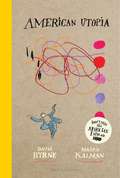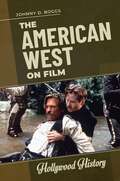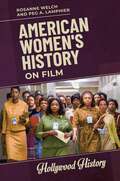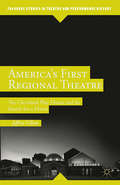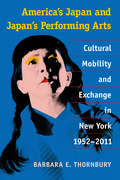- Table View
- List View
American Theology, Superhero Comics, and Cinema: The Marvel of Stan Lee and the Revolution of a Genre (Routledge Studies in Religion and Film)
by Anthony MillsStan Lee, who was the head writer of Marvel Comics in the early 1960s, co-created such popular heroes as Spider-Man, Hulk, the X-Men, the Fantastic Four, Iron Man, Thor, and Daredevil. This book traces the ways in which American theologians and comic books of the era were not only both saying things about what it means to be human, but, starting with Lee they were largely saying the same things. Author Anthony R. Mills argues that the shift away from individualistic ideas of human personhood and toward relational conceptions occurring within both American theology and American superhero comics and films does not occur simply on the ontological level, but is also inherent to epistemology and ethics, reflecting the comprehensive nature of human life in terms of being, knowing, and acting. This book explores the idea of the "American monomyth" that pervades American hero stories and examines its philosophical and theological origins and specific manifestations in early American superhero comics. Surveying the anthropologies of six American theologians who argue against many of the monomyth’s assumptions, principally the staunch individualism taken to be the model of humanity, and who offer relationality as a more realistic and ethical alternative, this book offers a detailed argument for the intimate historical relationship between the now disparate fields of comic book/superhero film creation, on the one hand, and Christian theology, on the other, in the United States. An understanding of the early connections between theology and American conceptions of heroism helps to further make sense of their contemporary parallels, wherein superhero stories and theology are not strictly separate phenomena but have shared origins and concerns.
American Theology, Superhero Comics, and Cinema: The Marvel of Stan Lee and the Revolution of a Genre (Routledge Studies in Religion and Film)
by Anthony MillsStan Lee, who was the head writer of Marvel Comics in the early 1960s, co-created such popular heroes as Spider-Man, Hulk, the X-Men, the Fantastic Four, Iron Man, Thor, and Daredevil. This book traces the ways in which American theologians and comic books of the era were not only both saying things about what it means to be human, but, starting with Lee they were largely saying the same things. Author Anthony R. Mills argues that the shift away from individualistic ideas of human personhood and toward relational conceptions occurring within both American theology and American superhero comics and films does not occur simply on the ontological level, but is also inherent to epistemology and ethics, reflecting the comprehensive nature of human life in terms of being, knowing, and acting. This book explores the idea of the "American monomyth" that pervades American hero stories and examines its philosophical and theological origins and specific manifestations in early American superhero comics. Surveying the anthropologies of six American theologians who argue against many of the monomyth’s assumptions, principally the staunch individualism taken to be the model of humanity, and who offer relationality as a more realistic and ethical alternative, this book offers a detailed argument for the intimate historical relationship between the now disparate fields of comic book/superhero film creation, on the one hand, and Christian theology, on the other, in the United States. An understanding of the early connections between theology and American conceptions of heroism helps to further make sense of their contemporary parallels, wherein superhero stories and theology are not strictly separate phenomena but have shared origins and concerns.
American Trade
by Tarell Alvin McCraneyWhen life in New York gets to hot to handle, charismatic hustler Pharus escapes the clutches of rap star Jules and moves to London. A funny, uncompromising about surviving in the big city that challenges our assumptions about racial and sexual identity, American Trade celebrates twenty-first-century London in all its extravagant diversity.Tarell Alvin McCraney's American Trade premiered at the Hampstead Theatre, London, in June 2011 in a production by the Royal Shakespeare Company.
American Travel Literature, Gendered Aesthetics, and the Italian Tour, 1824–62
by Brigitte BaileyOffers new tools from intermediality studies for analysing contemporary cinema
American Travel Literature, Gendered Aesthetics, and the Italian Tour, 1824–62
by Brigitte BaileyRestructures and revitalises late Romantic literature as a movement fascinated with competing claims about the reality and knowability of character
American ‘Unculture’ in French Drama: Homo Americanus and the Post-1960 French Resistance
by Les EssifA book about the role America plays in the French imagination, as it translates to the French stage. Informed by a rich variety of Western cultural scholarship, Essif examines two dozen post-1960 works representing some of the most innovative dramaturgy of the last half century, including works by Gatti, Obaldia, Cixous, Koltes, and Vinaver.
American Utopia
by Maira Kalman David ByrneFrom former Talking Heads frontman and multimedia visionary David Byrne and revered bestselling author, illustrator, and artist Maira Kalman--an inspiring celebration in words and art of the connections between us all. Don't miss the Spike Lee film of the Broadway hit American Utopia--on HBO.A joyful collaboration between old friends David Byrne and Maira Kalman, American Utopia offers readers an antidote to cynicism, bursting with pathos, humanism, and hope--featuring his words and lyrics brought to life with more than 150 of her colorful paintings.The text is drawn from David Byrne's American Utopia, which has become a hit Broadway show and is soon to be a documentary from Spike Lee. The four-color artwork, by Maira Kalman, which she created for the Broadway show's curtain, is composed of small moments, expressions, gestures, and interactions that together offer a portrait of daily life and coexistence.With their creative talents combined, American Utopia is a salvo for kindness and a call for jubilation, a reminder to sing, dance, and waste not a moment. Beautifully designed and edited by Alex Kalman, American Utopia is a balm for the soul from two of the world's most extraordinary artists.
American War Cinema and Media since Vietnam: Politics, Ideology, and Class
by Patricia Keeton Peter SchecknerNo other cinematic genre more sharply illustrates the contradictions of American society - notions about social class, politics, and socio-economic ideology - than the war film. This book examines the latest cycle of war films to reveal how they mediate and negotiate the complexities of war, class, and a military-political mission largely gone bad.
The American West on Film (Hollywood History)
by Johnny D. BoggsMore than a history of Western movies, The American West on Film intertwines film history, the history of the American West, and American social history into one unique volume.The American West on Film chronicles 12 Hollywood motion pictures that are set in the post–Civil War American West, including The Ox-Bow Incident, Red River, High Noon, The Searchers, The Magnificent Seven, Little Big Man, and Tombstone. Each film overview summarizes the movie's plot, details how the film came to be made, the critical and box-office reactions upon its release, and the history of the time period or actual event. This is followed by a comparison and contrast of the filmmakers' version of history with the facts, as well as an analysis of the film's significance, then and now.Relying on contemporary accounts and historical analysis as well as perspectives from filmmakers, historians, and critics, the author describes what it took to get each movie made and how close to the historical truth the movie actually got. Readers will come away with a better understanding of how movies often reflect the time in which they were made, and how Westerns can offer provocative social commentary hidden beneath old-fashioned "shoot-em-ups."
The American West on Film (Hollywood History)
by Johnny D. BoggsMore than a history of Western movies, The American West on Film intertwines film history, the history of the American West, and American social history into one unique volume.The American West on Film chronicles 12 Hollywood motion pictures that are set in the post–Civil War American West, including The Ox-Bow Incident, Red River, High Noon, The Searchers, The Magnificent Seven, Little Big Man, and Tombstone. Each film overview summarizes the movie's plot, details how the film came to be made, the critical and box-office reactions upon its release, and the history of the time period or actual event. This is followed by a comparison and contrast of the filmmakers' version of history with the facts, as well as an analysis of the film's significance, then and now.Relying on contemporary accounts and historical analysis as well as perspectives from filmmakers, historians, and critics, the author describes what it took to get each movie made and how close to the historical truth the movie actually got. Readers will come away with a better understanding of how movies often reflect the time in which they were made, and how Westerns can offer provocative social commentary hidden beneath old-fashioned "shoot-em-ups."
American Witness: The Art and Life of Robert Frank
by RJ SmithFrom the author of the acclaimed James Brown biography The One comes the first in-depth biography of renowned photographer and filmmaker Robert Frank, best known for his landmark book The Americans.As well-known as Robert Frank the photographer is, few can say they really know Robert Frank the man. Born and raised in wartime Switzerland, Frank discovered the power and allure of photography at an early age and quickly learned that the art meant significantly more to him than the money, success, or fame. The art was all, and he intended to spend a lifetime pursuing it.American Witness is the first comprehensive look at the life of a man who's as mysterious and evasive as he is prolific and gifted. Leaving his rigid Switzerland for the more fluid United States in 1947, Frank found himself at the red-hot social center of bohemian New York in the '50s and '60s, becoming friends with everyone from Jack Kerouac, Allen Ginsberg, and Peter Orlovsky to photographer Walker Evans, actor Zero Mostel, painter Willem de Kooning, filmmaker Jonas Mekas, Bob Dylan, writer Rudy Wirlitzer, jazz musicians Ornette Coleman and Charles Mingus, and more. Frank roamed the country with his young family, taking roughly 27,000 photographs and collecting 83 of them into what is still his most famous work: The Americans. His was an America nobody had seen before, and if it was harshly criticized upon publication for its portrait of a divided country, the collection gradually grew to be recognized as a transformative American vision.And then he turned his back on certain success, giving up photography to reinvent himself as a film and video maker. Frank helped found the American independent cinema of the 1960s and made a legendary film with the Rolling Stones. Today, the nonagenarian is an embodiment of restless creativity and a symbol of what it costs to remain original in America, his life defined by never repeating himself, never being satisfied. American Witness is a portrait of a singular artist and the country that he saw.
American Women Photographers: A Selected and Annotated Bibliography (Art Reference Collection)
by Martha KreiselAmerican women have made significant contributions to the field of photography for well over a century. This bibliography compiles more than 1,070 sources for over 600 photographers from the 1880s to the present. As women's role in society changed, so did their role as photographers. In the early years, women often served as photographic assistants in their husbands' studios. The photography equipment, initially heavy and difficult to transport, was improved in the 1880s by George Eastman's innovations. With the lighter camera equipment, photography became accessible to everyone. Women photographers became journalists and portraitists who documented vanishing cultures and ways of life. Many of these important female photographers recorded life in the growing Northwest and the streets of New York City, became pioneers of historic photography as they captured the plight of Americans fleeing the Dust Bowl and the horrors of the concentration camps, and were members of the Photo-Secessionist Movement to promote photography as a true art form. This source serves as a checklist for not only the famous but also the less familiar women photographers who deserve attention.
American Women's History on Film (Hollywood History)
by Rosanne Welch Peg A. LamphierBy exploring a range of films about American women, this book offers readers an opportunity to engage in both history and film in a new way, embracing representation, diversity, and historical context.Throughout film history, stories of women achieving in American history appear few and far between compared to the many epic tales of male achievement. This book focuses largely on films written by women and about women who tackled the humanist issues of their day and mostly won.Films about women are important for all viewers of all genders because they remind us that the American Experience is not just male and white. This book examines 10 films, featuring diverse depictions of women and women's history, and encourages readers to discern how and where these films deviate from historical accuracy. Covering films from the 1950s all the way to the 2010s, this text is invaluable for students and general readers who wish to interrogate the way women's history appears on the big screen.
American Women's History on Film (Hollywood History)
by Rosanne Welch Peg A. LamphierBy exploring a range of films about American women, this book offers readers an opportunity to engage in both history and film in a new way, embracing representation, diversity, and historical context.Throughout film history, stories of women achieving in American history appear few and far between compared to the many epic tales of male achievement. This book focuses largely on films written by women and about women who tackled the humanist issues of their day and mostly won.Films about women are important for all viewers of all genders because they remind us that the American Experience is not just male and white. This book examines 10 films, featuring diverse depictions of women and women's history, and encourages readers to discern how and where these films deviate from historical accuracy. Covering films from the 1950s all the way to the 2010s, this text is invaluable for students and general readers who wish to interrogate the way women's history appears on the big screen.
American–Australian Cinema: Transnational Connections
by Adrian Danks Stephen Gaunson Peter C. KunzeThis edited collection assesses the complex historical and contemporary relationships between US and Australian cinema by tapping directly into discussions of national cinema, transnationalism and global Hollywood. While most equivalent studies aim to define national cinema as independent from or in competition with Hollywood, this collection explores a more porous set of relationships through the varied production, distribution and exhibition associations between Australia and the US. To explore this idea, the book investigates the influence that Australia has had on US cinema through the exportation of its stars, directors and other production personnel to Hollywood, while also charting the sustained influence of US cinema on Australia over the last hundred years. It takes two key points in time—the 1920s and 1930s and the last twenty years—to explore how particular patterns of localism, nationalism, colonialism, transnationalism and globalisation have shaped its course over the last century. The contributors re-examine the concept and definition of Australian cinema in regard to a range of local, international and global practices and trends that blur neat categorisations of national cinema. Although this concentration on US production, or influence, is particularly acute in relation to developments such as the opening of international film studios in Melbourne, Sydney, Adelaide and the Gold Coast over the last thirty years, the book also examines a range of Hollywood financed and/or conceived films shot in Australia since the 1920s.
American–Australian Cinema: Transnational Connections
by Adrian Danks Stephen Gaunson Peter C. KunzeThis edited collection assesses the complex historical and contemporary relationships between US and Australian cinema by tapping directly into discussions of national cinema, transnationalism and global Hollywood. While most equivalent studies aim to define national cinema as independent from or in competition with Hollywood, this collection explores a more porous set of relationships through the varied production, distribution and exhibition associations between Australia and the US. To explore this idea, the book investigates the influence that Australia has had on US cinema through the exportation of its stars, directors and other production personnel to Hollywood, while also charting the sustained influence of US cinema on Australia over the last hundred years. It takes two key points in time—the 1920s and 1930s and the last twenty years—to explore how particular patterns of localism, nationalism, colonialism, transnationalism and globalisation have shaped its course over the last century. The contributors re-examine the concept and definition of Australian cinema in regard to a range of local, international and global practices and trends that blur neat categorisations of national cinema. Although this concentration on US production, or influence, is particularly acute in relation to developments such as the opening of international film studios in Melbourne, Sydney, Adelaide and the Gold Coast over the last thirty years, the book also examines a range of Hollywood financed and/or conceived films shot in Australia since the 1920s.
America's Church: The National Shrine and Catholic Presence in the Nation's Capital
by Thomas A. TweedThe National Shrine in Washington, DC has been deeply loved, blithely ignored, and passionately criticized. It has been praised as a "dazzling jewel" and dismissed as a "towering Byzantine beach ball." In this intriguing and inventive book, Thomas Tweed shows that the Shrine is also an illuminating site from which to tell the story of twentieth-century Catholicism. He organizes his narrative around six themes that characterize U.S. Catholicism, and he ties these themes to the Shrine's material culture--to images, artifacts, or devotional spaces. Thus he begins with the Basilica's foundation stone, weaving it into a discussion of "brick and mortar" Catholicism, the drive to build institutions. To highlight the Church's inclination to appeal to women, he looks at fund-raising for the Mary Memorial Altar, and he focuses on the Filipino oratory to Our Lady of Antipolo to illustrate the Church's outreach to immigrants. Throughout, he employs painstaking detective work to shine a light on the many facets of American Catholicism reflected in the shrine.
America's Church: The National Shrine and Catholic Presence in the Nation's Capital
by Thomas A. TweedThe National Shrine in Washington, DC has been deeply loved, blithely ignored, and passionately criticized. It has been praised as a "dazzling jewel" and dismissed as a "towering Byzantine beach ball." In this intriguing and inventive book, Thomas Tweed shows that the Shrine is also an illuminating site from which to tell the story of twentieth-century Catholicism. He organizes his narrative around six themes that characterize U.S. Catholicism, and he ties these themes to the Shrine's material culture--to images, artifacts, or devotional spaces. Thus he begins with the Basilica's foundation stone, weaving it into a discussion of "brick and mortar" Catholicism, the drive to build institutions. To highlight the Church's inclination to appeal to women, he looks at fund-raising for the Mary Memorial Altar, and he focuses on the Filipino oratory to Our Lady of Antipolo to illustrate the Church's outreach to immigrants. Throughout, he employs painstaking detective work to shine a light on the many facets of American Catholicism reflected in the shrine.
America's Corporate Art: The Studio Authorship of Hollywood Motion Pictures (Post*45 #21)
by Jerome ChristensenContrary to theories of single person authorship, America's Corporate Art argues that the corporate studio is the author of Hollywood motion pictures, both during the classical era of the studio system and beyond, when studios became players in global dramas staged by massive entertainment conglomerates. Hollywood movies are examples of a commodity that, until the digital age, was rare: a self-advertising artifact that markets the studio's brand in the very act of consumption. The book covers the history of corporate authorship through the antithetical visions of two of the most dominant Hollywood studios, Warner Bros. and MGM. During the classical era, these studios promoted their brands as competing social visions in strategically significant pictures such as MGM's Singin' in the Rain and Warner's The Fountainhead. Christensen follows the studios' divergent fates as MGM declined into a valuable and portable logo, while Warner Bros. employed Batman, JFK, and You've Got Mail to seal deals that made it the biggest entertainment corporation in the world. The book concludes with an analysis of the Disney-Pixar merger and the first two Toy Story movies in light of the recent judicial extension of constitutional rights of the corporate person.
America's Film Legacy: The Authoritative Guide to the Landmark Movies in the National Film Registry
by Daniel EaganAmerica's Film Legacy is a guide to the most significant films ever made in the United States. Unlike opinionated "Top 100" and arbitrary "Best of" lists, these are the real thing: groundbreaking films that make up the backbone of American cinema. Some are well-known, such as Citizen Kane, The Jazz Singer, All Quiet on the Western Front, The Birth of a Nation, and Boyz n the Hood. Others are more obscure, such as Blacksmith Scene, The Blue Bird, The Docks of New York, Star Theatre, and A Bronx Morning. Daniel Eagan's beautifully written and authoritative book is for anyone who loves American movies and who wants to learn more about them.
America's Film Legacy: The Authoritative Guide to the Landmark Movies in the National Film Registry
by Daniel EaganAmerica's Film Legacy is a guide to the most significant films ever made in the United States. Unlike opinionated "Top 100" and arbitrary "Best of" lists, these are the real thing: groundbreaking films that make up the backbone of American cinema. Some are well-known, such as Citizen Kane, The Jazz Singer, All Quiet on the Western Front, The Birth of a Nation, and Boyz n the Hood. Others are more obscure, such as Blacksmith Scene, The Blue Bird, The Docks of New York, Star Theatre, and A Bronx Morning. Daniel Eagan's beautifully written and authoritative book is for anyone who loves American movies and who wants to learn more about them.
America's Film Legacy, 2009-2010: A Viewer's Guide to the 50 Landmark Movies Added To The National Film Registry in 2009-10
by Daniel EaganAmerica's Film Legacy, 2009-2010Â is a guide to the most significant films ever made in the United States. Unlike opinionated "Top 100" and arbitrary "Best of" lists, these are the real thing: groundbreaking films that make up the backbone of American cinema. Each of the 50 newest titles in the National Film Registry is covered in a detailed essay that includes cast, credits, and major awards, as well as screening information and film stills. From well-known movies like The Muppet Movie and Dog Day Afternoon, to more obscure films, like A Study in Reds and Hot Dogs for Gauguin, Daniel Eagan's beautifully written and updated edition is for anyone who loves American movies and who wants to learn more about them.
America's Film Legacy, 2009-2010: A Viewer's Guide to the 50 Landmark Movies Added To The National Film Registry in 2009-10
by Daniel EaganAmerica's Film Legacy, 2009-2010 is a guide to the most significant films ever made in the United States. Unlike opinionated "Top 100" and arbitrary "Best of" lists, these are the real thing: groundbreaking films that make up the backbone of American cinema. Each of the 50 newest titles in the National Film Registry is covered in a detailed essay that includes cast, credits, and major awards, as well as screening information and film stills. From well-known movies like The Muppet Movie and Dog Day Afternoon, to more obscure films, like A Study in Reds and Hot Dogs for Gauguin, Daniel Eagan's beautifully written and updated edition is for anyone who loves American movies and who wants to learn more about them.
America’s First Regional Theatre: The Cleveland Play House and Its Search for a Home (Palgrave Studies in Theatre and Performance History)
by J. UllomThe Cleveland Play House has mirrored the achievements and struggles of both the city of Cleveland and the American theatre over the past one hundred years. This book challenges the established history (often put forward by the theatre itself) and long-held assumptions concerning the creation of the institution and its legacy.
America's Japan and Japan's Performing Arts: Cultural Mobility and Exchange in New York, 1952-2011
by Barbara E. ThornburyAmerica’s Japan and Japan’s Performing Arts studies the images and myths that have shaped the reception of Japan-related theater, music, and dance in the United States since the 1950s. Soon after World War II, visits by Japanese performing artists to the United States emerged as a significant category of American cultural-exchange initiatives aimed at helping establish and build friendly ties with Japan. Barbara E. Thornbury explores how “Japan” and “Japanese culture” have been constructed, reconstructed, and transformed in response to the hundreds of productions that have taken place over the past sixty years in New York, the main entry point and defining cultural nexus in the United States for the global touring market in the performing arts. The author’s transdisciplinary approach makes the book appealing to those in the performing arts studies, Japanese studies, and cultural studies.




